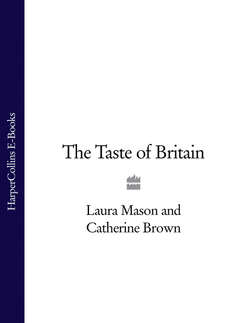Читать книгу The Taste of Britain - Hugh Fearnley-Whittingstall - Страница 18
HISTORY:
ОглавлениеClotting cream is really a means of lightly preserving it; when ordinary cream has been transformed into clotted cream it will keep in a cool place for about 2 weeks, as opposed to a few days. The method is probably very ancient and similar products are known in western Asia. Early references to clotted, or clouted, cream can be found in English texts from the sixteenth century onwards. The first mention cited by the Oxford English Dictionary is Boorde’s Dyetary of Helth (1542). A multitude of descriptions and references exist from the seventeenth century and later. Even the earliest references make clear that it was a regional product. Recipes show that the method for making it has remained essentially unchanged for 400 years.
This is a region with a mild climate, rich pasture lands, and a traditional cattle breed yielding milk with a high butterfat content, all factors conducive to the development of specialist dairy produce. Law’s Grocer’s Manual (c. 1895) remarks on ‘the increasing fancy for this delicacy’; that a regular sale for it was springing up in all large towns, and that the best was thought to come from Devon, notably the area around Ilfracombe. The cream was packed in small glazed pots for export to other parts of the country. Although the presumption is that clotted cream comes from Devon, it is equally known and long-established in Cornwall. The Devon connection probably took first place simply because it was the larger county, with wider connections to the country at large.
Once clotted, it was claimed the crust was sometimes solid enough to support a pound weight without breaking. Clotted cream has been used in the cookery of its region of origin (in breads, cakes, pastries, with fish, or as other regions might use cream); it is more generally thought of as a delicacy in its own right.
Clotting cream was also a very good way to turn milk into a flavourous butter. The heat-treatment required to make scalded cream and transforming the result into butter are 2 consecutive steps in preserving and adding value to a local raw material. ‘This cream was stirred by hand, the maid putting her arm into the pot and stirring it until the butter came. In hot weather when the hand was too warm, a bottle was sometimes used’ (Fussell, 1966). The existence of this butter was acknowledged by the author of the General View of the Agriculture of the County of Devon (1813) and, a century later, White (1932) writes about a Devonshire farmer’s wife demonstrating making butter by beating clotted cream with her hand. There is a view current that this form of butter-making is now more known in Cornwall than Devon. Small amounts are still produced in the West Country for local consumption. No other region of Britain has developed clotted cream, or butter made from it, as a speciality. Awarded Protected Designation of Origin (PDO).
